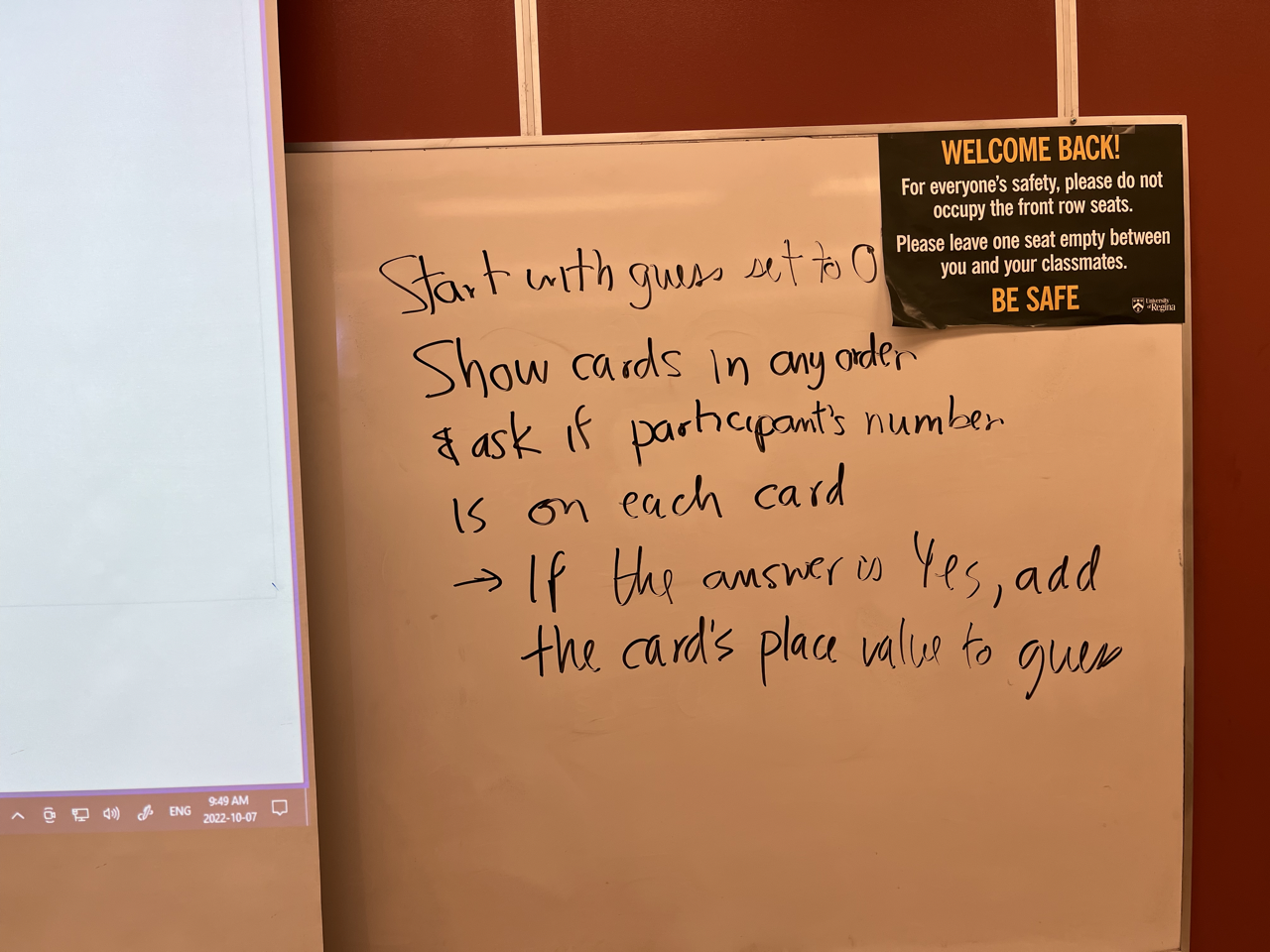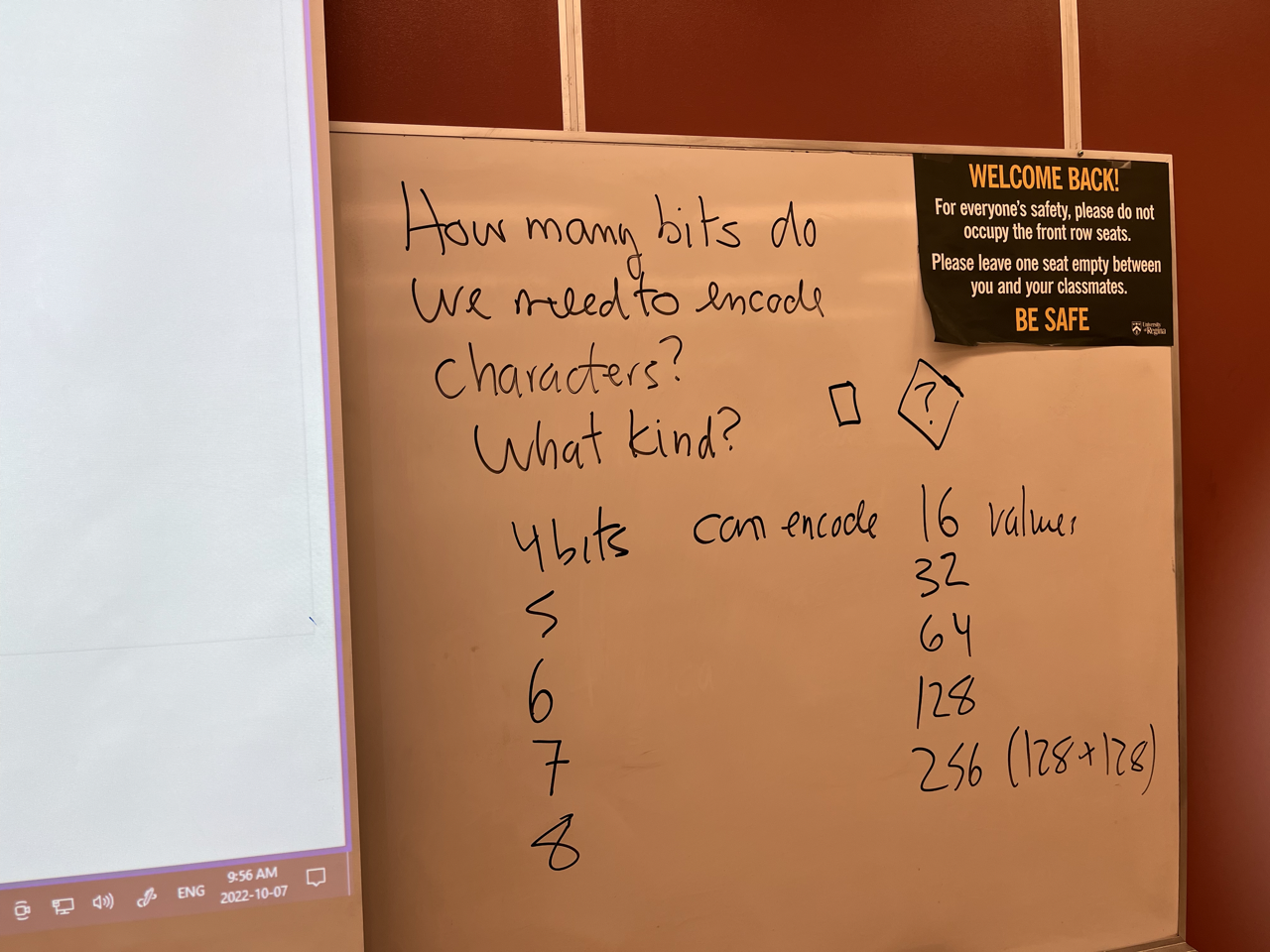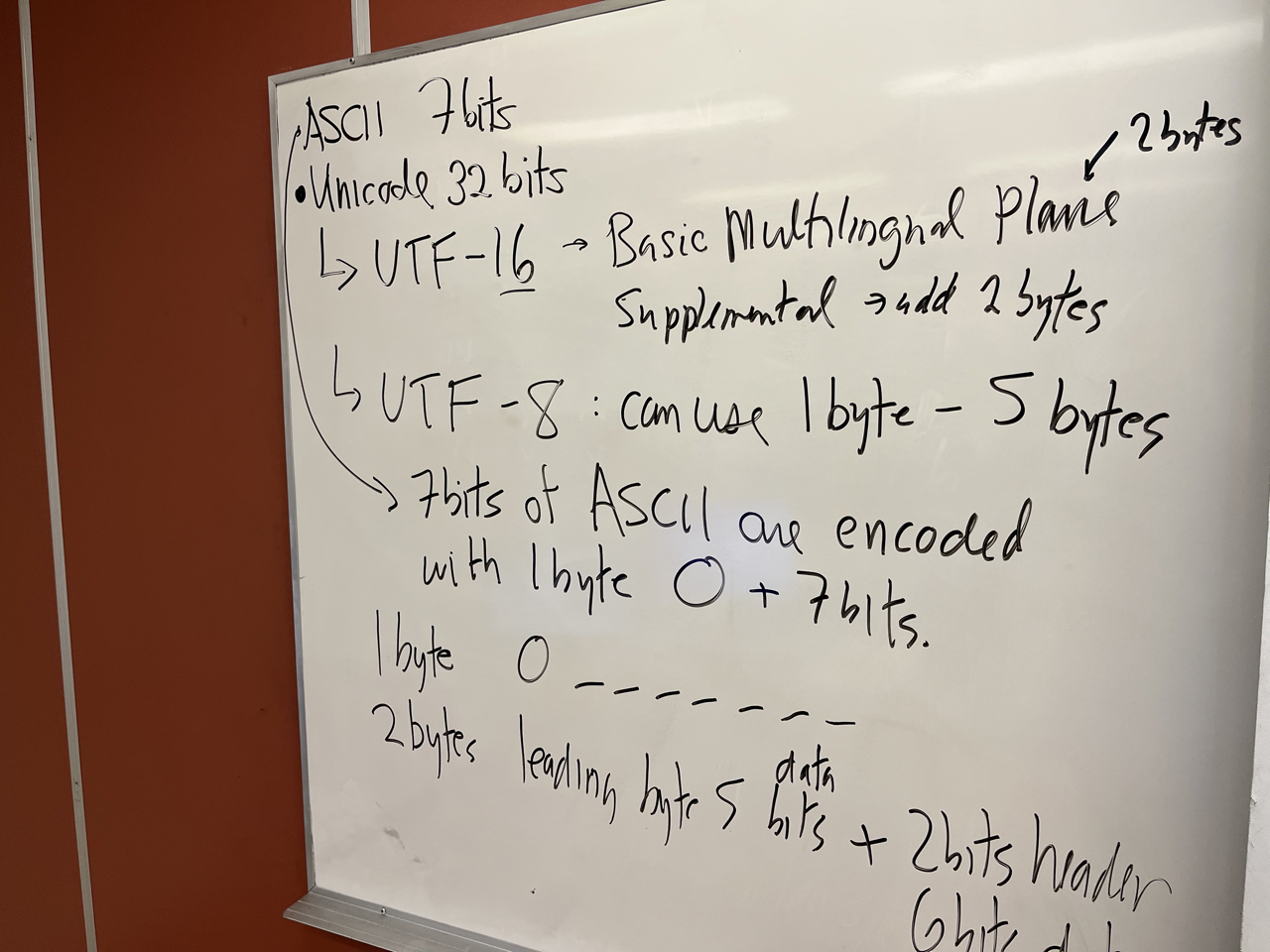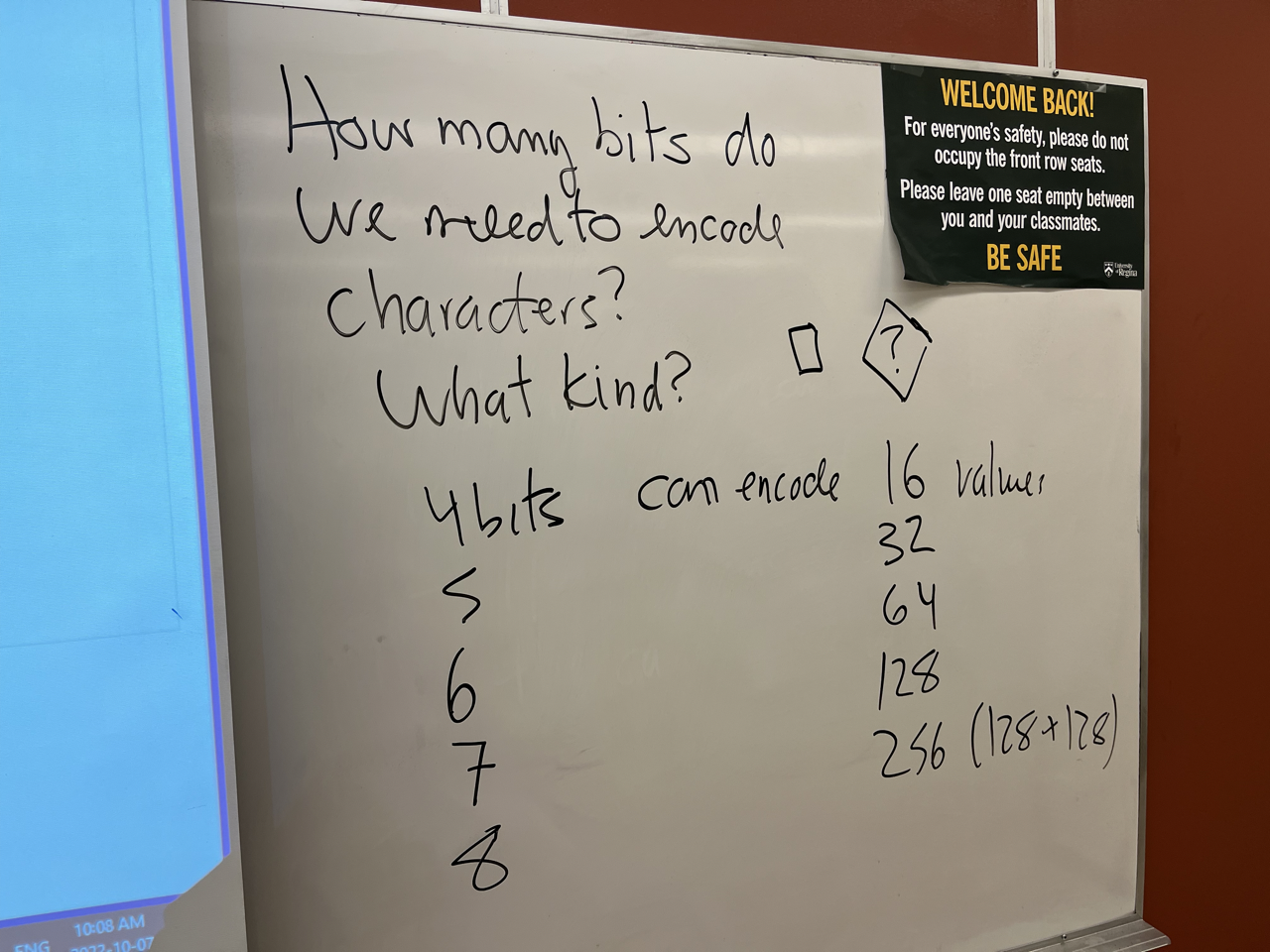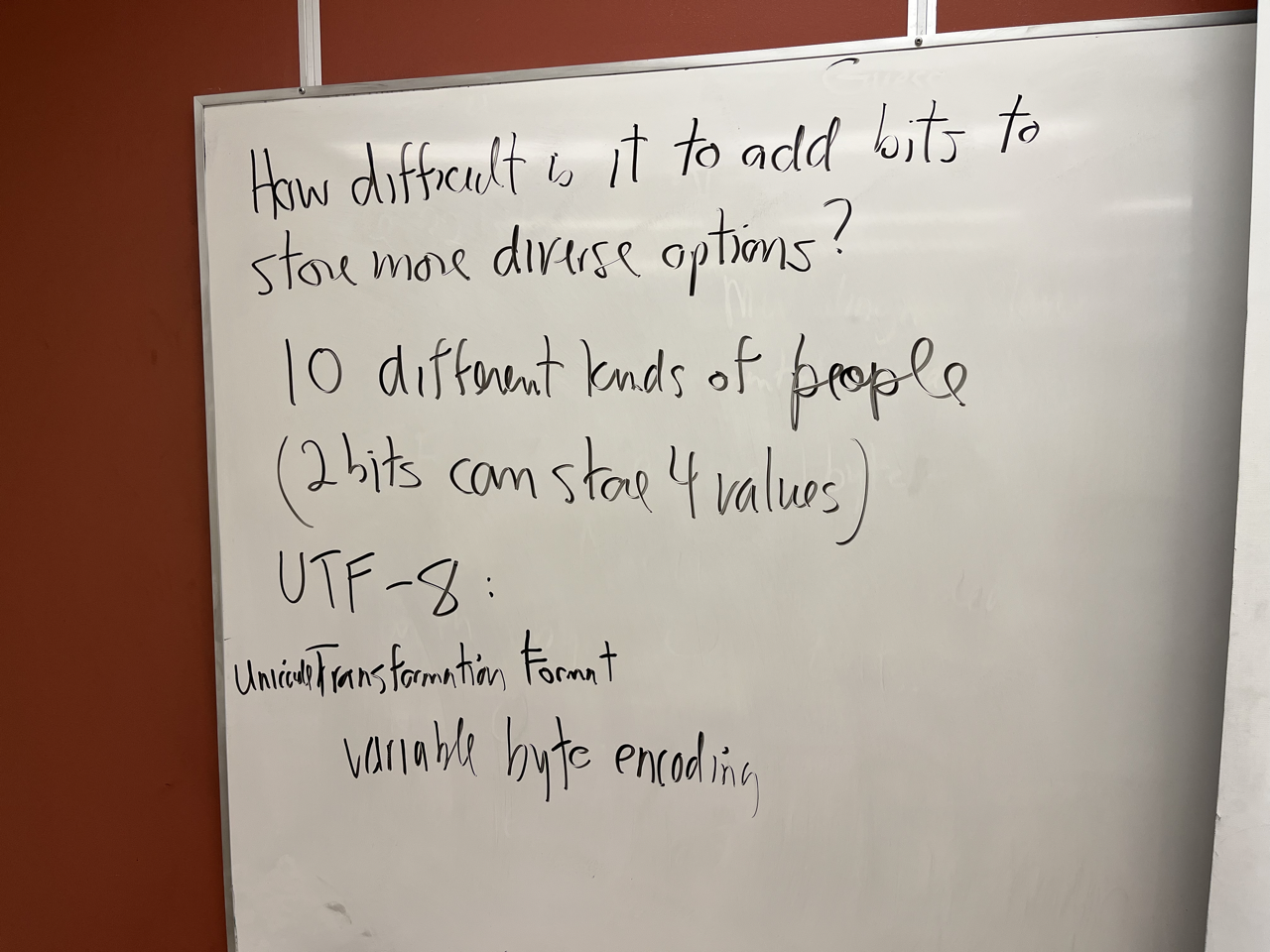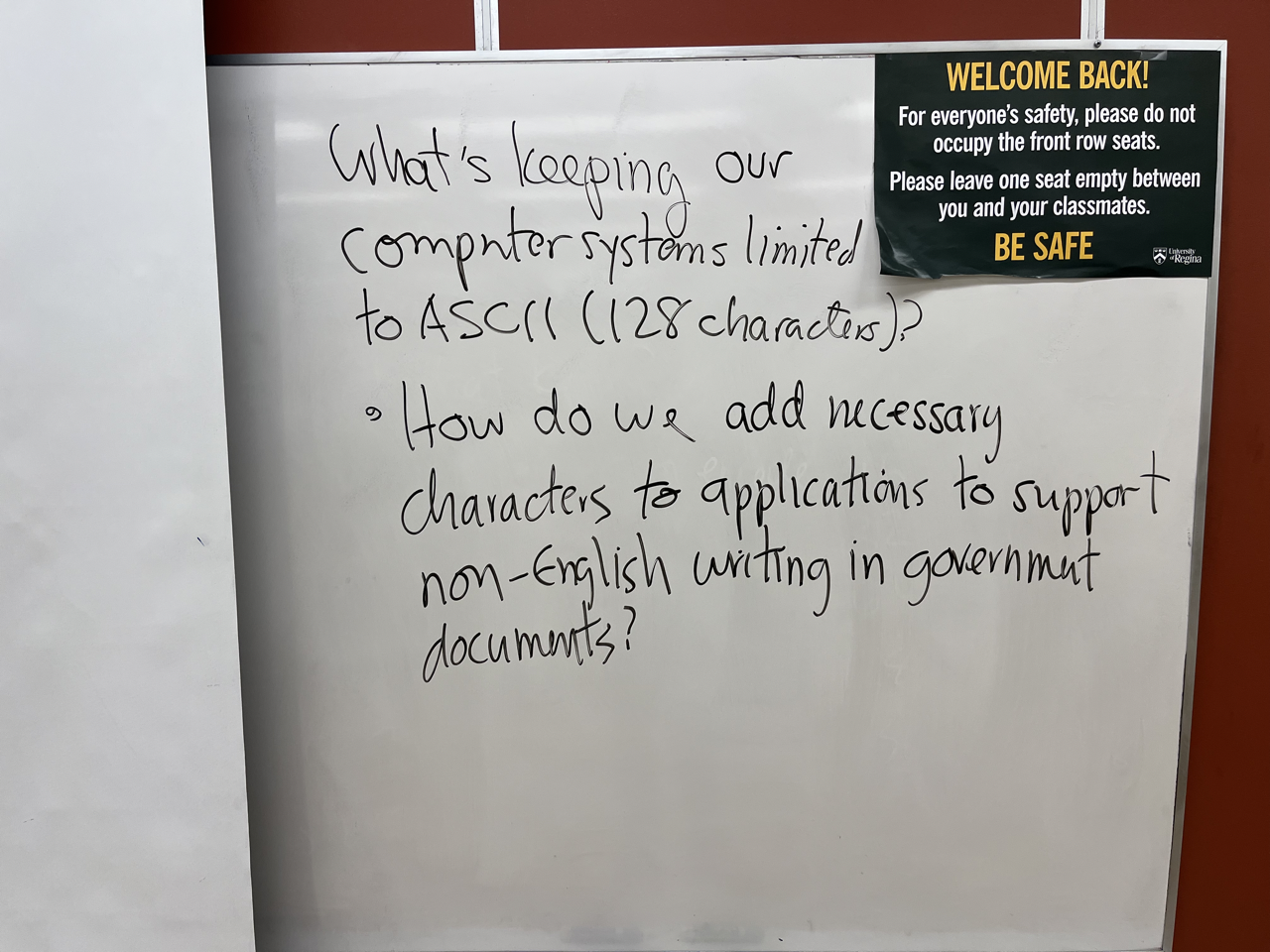Outline for Today
Administration
Media
Transcript
Audio Transcript
-
Somebody says I was so I brought the cards I promise your confirmation
-
I depending on the work that I started to work for you
-
thanks for joining us we cannot wish Laura Happy birthday she remember the bra the balloon Okay, so So I promised these cards the QR codes in the back so surely sorry Laura and
-
economics between zero and
-
and don't tell I'm going to Iceland for us depending on our guests you're not too far away because your number on this card the number on this card
-
yes okay is your number on this card as your number in this card numbers 11 So yeah not a numbers that are written back but there's actual secret information and the QR codes it's not I'm trying to joke anyway so just
-
so there's no
-
no tracks here. So there's a number two on the back. But it's also the numbers in the top right
-
or my other right, top left the four card for the top left and the one card as we've learned the top left and then the eighth card the date at the top left so
-
I'm gonna try another one. Because I picked that up other days the number of lines between zero and 15 Is your number and this number in this card number on this card this card yeah you want to talk about it or do you want to do another one
-
should we Okay, sure.
-
So you have more cards? Yes. And what's the total amount?
-
I'm asking you to guess and pick a number between
-
zero and 1516 guesses in two to the power of eight and 16. So what I'm thinking is that there are four cards with a combination of zeros and ones and if it's not on the side, that's a zero if it is on the card. It's a one and then you just translate the zeros and ones into a number.
-
I feel like we just make you stand up there and try to I don't know what
-
your response
-
is guess about how the
-
process is working. Everything is binary. So
-
that's basically it. It's to the forest is 16. And so So I'm asking you for yes or no questions. So
-
those are like
-
binary number binary digit spits. So when you say no, we're recording a zero or you're telling me a zero in that place and if you say yes, that's a one. So what's involved let's see if I say
-
so I have
-
if I say yes to these cards what's my number? Yeah. So the algorithm is simple. Start start with zero Evening Right. Trying a little bit different way to explain it. Does that make sense? So
-
the gist of what's going on is I'm asking you to tell me your number in binary. And then based on your yes or no answers. I convert it back to decimal. So just for fun, straight up the first verse 16 numbers in binary
-
so we started out with no so the next
-
one up is so it let's say you say yes to the one card
-
we know it's an odd number.
-
Yeah. So,
-
q is written as 10010 so this is the origin of the joke are 10 kinds of people in the world those who understand binary and those who don't.
-
Okay so we notice
-
the pattern is repeating the pattern yours. No, yes, no. Yes. And then we have no no yes, yes. So what what are the next four numbers going to be like? Yes, yes, yes, yes. Yes, and these are going to be yes.
-
And then we just copy the pattern we haven't been here yet. So these are going to be no
-
so 0100 or 24010167? And then for the last cards and these are all going to be are going to say yes to the number being on the eighth card so we can see so what are the numbers that are on the card are the ones we're saying? Yes. So 1357 So we did we did zero to seven. So that's the first column on the card. And then for the two card. We've said yes to two three, and six and seven. So that's the first column on the food card.
-
And then
-
the fourth card we have 4567 and that appears in the first column and then the eighth card we just kind of every the numbers are hated about so I still have a few of these in my office.
-
Come and see me pick up
-
to can entertain your friends and family of thanksgiving. That makes sense. So how many cards do we need? Or how many beds do we need to encode characters am persistent,
-
is that a 32? Generally for ASCII ASCII stupidities,
-
is it log
-
okay so yeah,
-
most of you are for last season. So, do you need that? How many weeks do we need for scanning accordingly for how many weeks to get the data
-
I'm not really talking about QR codes is the answer. You're looking for. 30 twos in general
-
it's not it's not it's not that's anyway
-
so QR codes have some redundancy. So we can verify we can get the same answer a few different ways to assure that we're reading correctly. But I'm just talking about so four cards, four beds, four binary bits, we can store 1516 values. Start with zero and go up to 53. We ended up with four zeros to start with and then we had four ones. So we can if we have space for four bits and we can store 16 different values.
-
It can be the first 60 letters of the English alphabet or something else but because only part of the alphabet isn't necessarily so useful for writing, emails and so on. Maybe we should be able to encode more characters.
-
So if we have
-
so in five bits we can encode 32. So it's like decimal numbers, except by numbers were doubling instead of multiplying by 10 with each added bit so five bits we could encode 32 values 664 So we can probably do a pretty good job with 64 bits for North American English without an accent and so on. And actually, he asked he Saturdays is seven minutes so it leaves one for error checking but in order to get some more capabilities within the ASCII system standards use a specified different. So we have a Sam 128 from ASCII, and then we have
-
another set of characters setbacks and so forth. And the issue is we have to choose which additional set of accent. So characters you want to include. So there's lots of different variations
-
using eight bits. And they're different, incompatible they're compatible on the 1.8 but then extra 128 match up to adult we don't agree and you got some strange characters like box we can question mark or some strange combination of letters the adult look out of place I mean they look like through letters but
-
anyway so the ASCII character set is, is quite nice, I think because it's designed so you
-
can shift you can go from lowercase, uppercase. By shifting bets. And the numbers are for anyone who saw some nice features. And there are some characters in there that are TTY codes that I think are never are no longer practically used. So ASCII stands for the American Standard Code for Information Interchange. And so fun fact you can use it Artis Well, certain kinds of parties maybe if you're going to an event, celebrate texting day, us so last week, Monday
-
then that's the kind of stuff you would help you out. So,
-
in order to be more inclusive, we have the idea of Unicode now which is four bytes, four bytes or 32 bits. There are
-
different ways to encode them. So we can encode them
-
using two bytes. And this is what's done on Windows. So it's either on big that will suit you best divide them into planes and the basic multilingual plane gets two bites. haven't forgotten interfaces design course. I'm trying to bring us around that point. So this is two bytes. So two times I guess the 16 and then there are
-
I'm not sure if I'm using these terms exactly the way you know. So the ones that are done. So what's the basic claim then we and somebody we use another so if UTF eight, we can we're always going to use 16 bytes and minimum. Maybe sometimes we're using 32 to encode characters. So was that? Not so eloquent introduction what characteristics do you think UTF eight has. So it's not about the languages it's about different encoding characters, different characters.
-
accented characters.
-
So the characters are in Unicode. So they're always have they're defined with using 32 bits. These are different ways to represent the Unicode called code points in a more efficient manner. So in UTF, 16, we're going to use 16 or 32 bits to encode characters. So if we can use 16 bits then we're saving reducing our space for the document by half. Yes, UTF eight or using eight bits isn't this basic?
-
And I think it goes up to five bytes.
-
So if UTF 16 is confusing
-
I don't want to put that up. I don't want to make you think that UTF 16 Isn't isn't a valuable tool
-
but I think UTF eight is a little bit more clear. Especially if we're learning with ASCII. So meeting zero us.
-
So, the thing that I have not stated
-
explicitly here is the Unicode is set up so that the first 128 values match up with the ASCII character set. So when we're dealing with North American English, and we have web pages that are encoded in UTF eight then we're able to mostly
-
use one byte per character. So that makes sense. So we had one byte it gives you this zeros and they're seven bits to fill in two banks I have to look up what the first bite looks like. So there's
-
think there are I think it's 40 minutes, late in the first night. And then and then betrayed then the next day as it started with 01 to indicate that it's there one zero.
-
It's 95.
-
So we can start with 11 by bits.
-
Those who buy
-
zoom you can store up to 21 bits of data
-
in in five bytes.
-
So that gives us a lot of expressive power. So in the UTF eight we could
-
you could encode more characters. But it's by agreement, it's limited. It's set to represent the same characters are representable using UTF 16. And there's still millions of characters left that are unsigned so you should be okay with those. Okay,
-
so here's where I'm gonna venture into the interface design portion. It's my intent anyway. So the question is a question is. So there's a story on the Nash national news boss you could leave before about how First Nations woman was trying to get her kids names spelled properly on their government documents and the character that was missing was a glottal stop. So that's certainly available within Unicode. But how do we get. So it's it's a question of design and it's also a question of storage as well.
-
So for the most part, if if we use UTF, eight encoded
-
names, most of the time we're going to end up with the same they're going to be the same size as zeros original ASCII, but at times you're going to be larger. So the other thing, the example that came up came to mind for me was talking about people were allowed to indicate X for agender on a on an identification so that seems to me to be also a question of storage. So if we have one bid allocated for gender then we have two choices.
-
So how difficult is it to
-
earn an extra bed in that field?
-
So the joke is there are 10 kinds of people.
-
Those who understand binary and those who don't really even make a joke work we're using. We're using qubits. So we can actually store four different values. So any comments or questions about that? This anatra changing the database so that we add more bits are there other issues that are involved?
-
Is it one a few tips concerns tip not just us. It's the use of bits efficiently
-
Yeah, okay, so. I invite you to check my
-
expansion of this abbreviation. He was definitely Unicode. key I think is transformation and F is format.
-
Code transformation format is correct.
-
They say transformation or they say transfer anyway.
-
The transformation
-
I have a worksheet
-
for UTF eight characters I'll share that with you if you're interested. So, yes, we're the goal is we can have a very variable PID encoding
-
or variable by. So, ASCII is a popular format and so it's preserved. So that's another nice feature. But we're dealing at the byte level so we can we can be more efficient than at the byte level.
-
I think maybe we could be.
-
We divided the 128 characters and ASCII into groups of 64
-
Because there's 26 letters,
-
so we shouldn't be able to do a fair job with
-
that. But anyway,
-
there's a lot of there's trade offs there. One sided was the unit size to use. And this one seems to be
-
a good trade off I think. So
-
trying to be efficient with UTF, eight, and even with UTF 16. Not as quite as it's it's going to be twice as large for an English encoding of English next North American English text. So that makes sense. So many people are explicitly using UTF eight and when you do web pages Okay. Few people sounds good. Any thoughts about sort of the real life implications of limiting the bits that we're storing? To discourage? Well, not maybe not. Intentionally discouraged, but limiting diversity in the options we can represent. Okay, good time stop for the day. Well, there we go. Yes. Thank you very much for today. Have a good long weekend. Happy Thanksgiving. Happy birthday, Laura.
-
trying to be efficient with UTF, eight, and even with UTF 16. Not as quite as it's it's going to be twice as large for an English encoding of English next North American English text. So that makes sense. So many people are explicitly using UTF eight and when you do web pages Okay. Few people sounds good. Any thoughts about sort of the real life implications of limiting the bits that we're storing? To discourage? Well, not maybe not. Intentionally discouraged, but limiting diversity in the options we can represent. Okay, good time stop for the day. Well, there we go. Yes. Thank you very much for today. Have a good long weekend. Happy Thanksgiving. Happy birthday, Laura.
Responses
What important concept or perspective did you encounter today?
- The number guessing game is the representation of the binary number bits and if anyone can know the tricks of it. Then it is very easy to solve the number. But at the beginning it seems very complex when you do not know what is the binary bits. So that the 4 cards can guess the number 0 to 15 if the card number would be more then it would be increase the range. The ASCII and the unicode also the represents of the value of the computer by using the binary bits.
- Today Dr. Hepting did a fun activity where he held four cards and asked a student to guess a number then using a series of yes and no he guessed the correct number. Then he explained how binary numbers works and then we discussed how many bits would we need to fit no English characters in government documents/ID. Dr. Hepting brought up a woman’s story where she had a hard time correcting her name on her government ID because of one invalid character in her name.
- Today I have learned and recalled some of my previous knowledge of ASCII and Unicode. Using ASCII, representation of all the character is not possible. That’s why we cannot make our scope open for creating the visual representation for all the characters we need.
- In today’s lecture we discussed about ASCII and it’s complexity limited to the programming boundaries. It was fun and interactive.
- How binary code can be used to impress those that do not understand binary
- Today professor talked about ASCII code and Unicode, I understood that is method of Encoding text.
- We learned about the UTF and UTF-8 which is an encoding and decoding unicode. UTF-8 is mostly used because it is easier as we don't have to store all the values.
- The most important thing I learned today was how we might consider the future, when designing for the present with limited boundaries. This is a very important question, since we do not know what we might change in the future, and so we are just designing with a complexity that we might not need. However, if we ever need to make changes, our hands will be tied with the boundaries for the previous design.
- Happy Birthday Laura!! The binary card guessing game is a great thing to show off to my family this weekend. Can’t wait to confuse them
- Applicability of bits. I understood bits through previous CS courses, but today's card example exposed me to the practical side of connecting bits with design. Especially with the discussion of adding necessary characters to support non-English writing to government documents It made me reflect on how technology and interface are intermingled as when technology develops, the possibilities for interface and human interaction with technology develop(e.g. accessibility options on websites)
- The most important thing I learned today is about UTF. UTF is an encoding system that decodes and encodes Unicode. Most programmers use UTF-8 than UTF-32 because they usually do not need to store all possible Unicode values.
- Prof taught us a card guessing
- Daryl in this meeting played card games to guess a number! At first, he talked about the card game and how the answers to the questions translate into binary numbers, which we can translate into a binary number and find the answer. So it’s important to know how many bits we need to encode characters and what kind of that. In the next 15 minutes he talked about, ASCII 7 bits, and Unicode 32 bits charsets and talked about each shortcoming.
- Today I learned about encoding the characters with ASCII, Unicode, UTF 16 and UTF8.
- We had an interesting game in the class. gussing answer and how the answers translated to the binary numbers. We can translate it into a binary number and in this way we can find the answer. Also, we talked about the different ways to encode and to represent unicode.
- In today's meeting we discuss about the binary, Ascii numbers we play a card game also.
- The most important thing I learnt was encoding character and what is the difficulty level to add bits to store more diverse options. I would still love to learn a bit more about it because I found it as avery interesting topic
- started with "happy friday," the most important thing I learned was about the card game's logic. The professor bought 4 cards and asked random students to come up with a number in their heads. He then asked them to start at 0, show the cards in order, and ask participants if the number is in each card. If the answer is "yes," he added the cards' place values to guess. Participants also discussed how many bits are required to encode characters with 4 bits
- Dear Prof. Hepting. Today you brought some cards and asked some of the students to consider a number in their mind. Then, you told the number by asking yes/no questions. The reason for bringing this game was teaching how encoding works. Thanks
- Today I got to know the logic behind the card trick professor showed,
- today we did play the number game and then learnt the binary code mechansim from it. we also discussed adding and storing of bits.
- UTF-8 are mostly used in storing the multilingual character and usually the most popular encoding method in World Wide Web.
- The most important thing I learned today is about the card game and how the answers to the questions translate into binary numbers, which we can translate into a binary number and find the answer
- In this lesson, we focus on the permutation of the truth table for various possibilities. The analysis considers how many different combinations there are of the whole card.
Was there anything today that was difficult to understand?
- I'm not too sure why the binary guessing game was necessary to talk about encoding, especially when it was explained in that level of detail. It is a fairly trivial concept that is taught in CS100 and CS110, and probably didn't need a 20 minute explanation in a fourth year course, especially when it is not really related to interface design at all.
- Since today was a student’s birthday, the professor did an interesting activity where he had her guess a number between 1 and 15 and using various cards with numbers on them, guess the number. We also explored the bits on ASCH code as well. Although it was an uninteresting discussion, I don’t understand exactly how it relates to user interfaces.
- The most difficult thing for me to understand in today's meeting is what keeps the computer system limited to 128 characters.
- The most difficult thing for me to understand today is the ASCII, the encode things are really hard to understand
- For me, it was difficult to understand UTF and ASCII.
Was there anything today about which you would like to know more?
- In today's class we discuss about the card game and how that answer converted into binary answer. I would like to know about this games.
- In today’s meeting we saw that DR Helpting modified the QR code for the attendance and then afterwards we discussed about the ASCII code and how that works in binary guessing game. I would like to know more about how that works in detail.
- Today I’d learnt through the card game, the problem faced by today’s computers of being limited in terms of the input options and I’d like to know and explore more ways in which this barrier could be overcome.
- UTF 8 and UTF 16 is something important I learned. The binary game is amaz
- I would like to know more about the binary game concept as it seems pretty interesting and also there it is available in a variety of ranges. It can either be played solo or in group and either with number or with alphabets. But as the name itself depicts that usually revolved around numbers and we either have to change the binary digits by clicking on them to make the total for that row or type in the total for the binary digits given. But overall I really enjoyed today's class.
- Our computer system is limited to ASCII because it is commonly used to give our computers the same language which allows sharing of files. ASCII is large enough for US English but not for universal use. A quick Google search shows that extended ASCII is available but I'm not sure if it is widely used to support non-English writing in government documents as discussed in class. I'd like to learn more about how government plans to deal with this issue.
- I would like to know more about how I can represent characters from different languages so that it is more inclusive
- Today we discussed a problem about encoding characters.
- I would like to know more about how digital data is important also about UTF
- udt8 time zone and how it works
- Today, we discussed the binary guessing game and it was kind of difficult for me to understand how it worked. I would want to learn more about this game.
- The way how other characters apart from English alphabets can be stored and used in the system and how bits are used to store this value. It's interesting to study and understand that part of computing and designing.
- I am interested in learning how computers are able to display different alphabets using the same bits, and whether it is labour intensive to switch between these alphabets.
Wiki
Link to the UR Courses wiki page for this meeting

